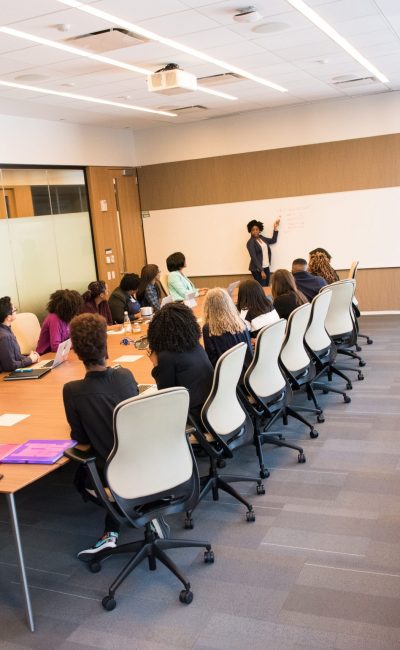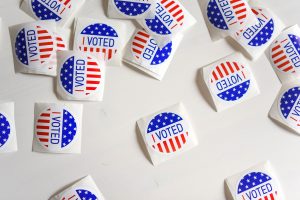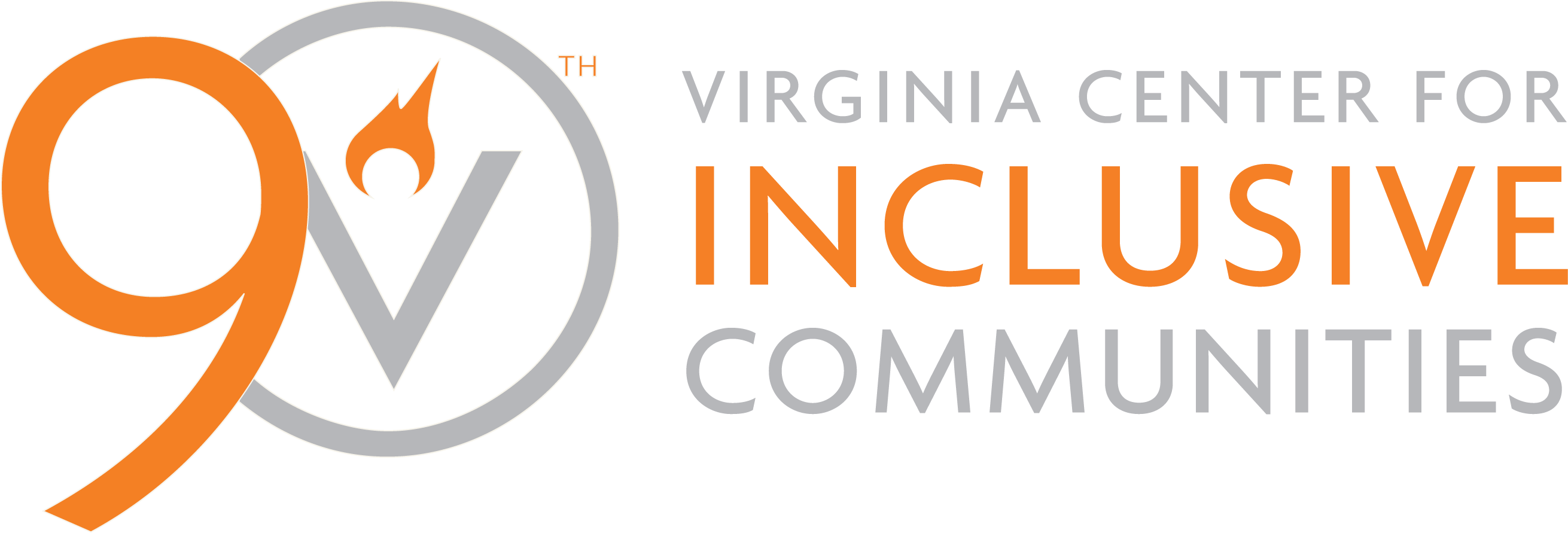Day After Election Guide
A Resource for K-12 Educators and Administrators
* UPDATED FOR 2024 *
In 2016, the Virginia Center for Inclusive Communities was overwhelmed with urgent requests from schools after incidents of bias, bullying, and discrimination. A significant number of these incidents were connected to the 2016 Presidential election cycle: students repeating statements they had heard from politicians, educators and parents not knowing how to respond to major events in the news, and a pressing concern about the decline of civility in public discourse. An important lesson from 2016 was the importance of intentional, proactive planning.
This Day After Election Guide was initially designed to support educators and administrators in preparing for the 2020 Presidential election. It has been updated with additional resources and recommendations for the 2024 Presidential election.
The key message from the Day After Election Guide is that a school’s plan for the day after the election should actually be their plan for the entire school year. That means that classroom lessons, educator professional development, and communication with parents and guardians throughout the school year should clearly establish and reinforce expectations about how to show respect for one another and how to explore controversial or difficult subjects.
All schools should be places of belonging for every student. When students feel like they fully belong, they are more likely to raise their hands, do their homework, care about the quality of their work, look out for others, and perform at their best. Schools that foster inclusion and belonging therefore become more successful. Especially at moments that can feel divisive like an election season, schools have an important responsibility to foster a sense of belonging.
As one school administrator shared with the educators at his school, “I hope that you will be politically ambiguous but morally crystal clear.” In other words, while educators have a responsibility to not be partisan, they similarly have an obligation to communicate their classroom and school values on an ongoing basis. Doing so early on can help to prevent incidents of bias, bullying, and discrimination. And, if those do occur, relying on a strong foundation can help a classroom and school learn, heal, and move forward together.
This information on this page can also be found as an online document and as a downloadable pdf.
Topics
Classroom Climate
Students who report feeling safe, respected and included in their classrooms are more likely to succeed academically than students who do not perceive their classroom to be a positive learning environment.
Building a positive classroom climate is especially important in a Presidential election year because it can provide students with the tools and skills to successfully interact with teachers and classmates who differ from them – politically or otherwise. The work of building classroom climate should begin the very first day of school and focus on building empathy, establishing classroom norms, fostering positive peer interactions and relationships, and providing spaces in which students can learn to communicate effectively and respectfully with classroom peers. Below are evidence-based strategies teachers can employ to establish a positive classroom climate during the election.
Establish Classroom Norms
Engage students in the process of creating a class contract that specifies what behaviors are appropriate and expected leading up to, and following, the election. For example, “Listen to others’ opinions.” Ensure that all students agree to follow the established norms. Make the contract visible in the classroom so that it can be easily referenced. If students help create the contract, they are more likely to follow it.
“Without trust, a teacher cannot connect with students. I spend time each class period during the beginning of the school year getting to know my students and letting them get to know me. I work to ensure that class is a safe space through a variety of activities. One of my students’ favorite activities is establishing the norms for class. I then print the norms in poster-size and post them in the room. I make sure that they know we are all expected to adhere to them – myself included.”
– High School Teacher
Foster Positive Peer Interactions and Relationships
Intentionally create collaborative groups that include students from diverse backgrounds. Assign group work that promotes cooperation (not competition), positive interaction, and working towards a common goal. Teach students how to support one another in collaborative groups and otherwise. For example, challenge your students to think about how they could be an effective ally. Possible responses include speaking up in the moment, getting help from a trusted adult, or talking with classmates privately.
Teach and Provide a Safe Space for Respectful Communication
Make “Morning Meeting” a daily practice. Start each day with a meeting that provides a safe and inclusive space for students to respectfully share their feelings. Work with students to establish expectations for communicating, role play appropriate sharing and active listening, and provide students with constructive feedback. As you get closer to the election, your class will have a designated time and space to discuss their emotions. Consider prompts such as: “Name one emotion word that describes how you are feeling about the election and one reason why you are feeling that way.” or “For people who are sad or disappointed about the election, what is one thing you could do to support them?”
“I do a trait of the month. We read a book about the trait, and I display quotes that are about the trait. We have class discussions about it. I am intentional when selecting read-alouds and use the books to discuss and reflect upon character traits of not only the characters in the books but also of the students in the class.”
– Elementary School Teacher
Build Empathy
Help students develop their perspective-taking skills to build empathy. Reference books that your class has read and invite students to consider how the story would be told from the perspective of a different character. Use the prompt “How would you feel?” when discussing conflicts or relational aggression. Alternatively, discuss the phrase “walking in someone else’s shoes.” Have students think and write about how they would feel in different scenarios.
Introduce Mindful Practices
Mindfulness techniques and practices in the classroom can help students regulate their nervous system and navigate difficult or complicated emotions that may arise during the election season. Practice having a “mindful moment” together at the beginning of the school day or period to build a sense of community. Utilize apps and videos to teach students new breathing techniques that they can come back to in stressful moments. Designating a corner or space in your classroom where students can go when they’re seeking a short break can help students find a peaceful place to calm their emotions if tension arises.
GO DEEPER:
• VCIC’s “Back to School with Belonging” Guide has dozens of evidence-based practices to support belonging in the classroom
• VCIC’s “Guide to Constructive and Inclusive Dialogue” offers frameworks and tools to foster dialogue
Curriculum
With the election already on students’ minds, offering structured opportunities to discuss their beliefs and opinions allows students to develop media literacy skills and practice civic dialogue. These conversations should be guided by discussion and deliberative dialogue rather than debate. These approaches allow for more critical engagement and analysis in keeping with the classroom climate and norms you have established.
One tool that educators can use when discussing current events and controversial issues is a KWL Chart. By having students reflect on and then engage what they know (K), what they want to know (W), and what they have learned (L), educators can provide structure and direction for focused learning. Whenever engaging students in such discussions, educators should emphasize up front that hatred or targeting of a group based on identity (gender, nationality, race, religion, sexual orientation, etc.) is not an acceptable political position to bring up in the classroom.
– Elementary School Teacher
There are many ways to incorporate thoughtful lessons related to the Presidential election into curriculum.
English
Read texts about past elections or that help to model empathy when characters disagree
History & Social Science
Learn about significant elections throughout United States history or about diverse political systems throughout the world
Mathematics
Analyze statistical polls or election results from past Presidential elections
Science
Consider how scientifically based techniques are used for polling and voting machines
World Language
Research elections throughout the world and the similarities and differences with the political system in the United States
GO DEEPER
Professional Development
From the very beginning of the school year, educators should be reminded of school expectations related to the 2024 Presidential election. It is important that there is consistency within a school so that students are not having markedly different experiences in different classrooms when it comes to engaging the issues associated with the election.
After providing clear guidelines, administrators should dedicate specific time during professional development sessions to share scenarios that could come up and invite educators to share possible responses. These could be proactive (such as asking how educators could adapt lessons based on the election) and reactive (encouraging educators to consider how they would respond to comments a student might make). This opportunity to brainstorm will ensure clear and consistent understanding of school expectations, while also giving educators the opportunity to gain comfort in handling specific situations.
As the 2024 Presidential Election approaches, administrators should continue to reinforce expectations at faculty meetings, while also allowing educators to ask questions . They should also have a plan to provide space for educators to process how they are feeling, particularly in the days immediately following the election.
– School Administrator

Communication
Administrators should consider three opportunities during the 2024-2025 school year to send messages to parents and guardians about the school’s expectations and plans related to the Presidential election:
- First, at the beginning of the school year to be clear about overall school norms and expectations
- Next, one or two weeks prior to the Presidential election to reinforce the opening message
- Finally, immediately following the Presidential election to communicate how the school is moving forward
All three messages should encourage the entire school community to partner in embracing core values connected to respect, dialogue, empathy, and cooperation. They should highlight any events or initiatives that the school or district is undertaking, and they should encourage families to have respectful dialogues that complement the school’s approach, providing sample resources if possible.
Responding to Challenges
Even with the best planning, there are times when unexpected challenges can emerge.
In the 2024 election cycle, these challenges could include:
- A student complains that her first amendment rights are being infringed because she was told to remove a political sticker from her personal laptop.
- A parent complains that the school is promoting a political agenda by having a program that supports immigrant students.
- While sitting in the stands during a school athletic event, a parent can be overheard making partisan statements.
- A student is told that it is not appropriate to make a particular statement in class and responds by saying, “but [CANDIDATE’S NAME] says it!”
Here are some general considerations for how to respond in those moments:
- Rely on your existing classroom practices and norms. Have an extra morning meeting. Refer to a recent text or lesson related to empathy.
- Do not ignore discriminatory behavior or words. Your silence suggests that you tacitly approve.
- Ask simple, exploratory questions without aggression. Doing so can open up communication and clarify the root of the student’s beliefs so that you know what information you need to convey. Asking for more information also lets the student encounter their own bias.
- Age appropriate responses:
- For younger grades, discuss why some words hurt. This might be a time to explain what bias and prejudice are. Don’t oversimplify your language. Prejudice and bias are not just “not nice.”
- GO DEEPER:
– Talking to Kids about Discrimination (from the American Psychological Association)
– Talking to Young Children about Bias and Prejudice (from ADL)
– Teaching Young Children to Resist Bias (from PBS)
- GO DEEPER:
- As students get older, you can begin to explore the historical context, tying it into social studies lessons. “Do you know the history of that word?”
- For younger grades, discuss why some words hurt. This might be a time to explain what bias and prejudice are. Don’t oversimplify your language. Prejudice and bias are not just “not nice.”
- Be prepared to act. Avoid being stuck after a student or colleague says something biased by practicing your strategies for responding. Promise yourself that you will speak up.

GO DEEPER:
- The Virginia Center for Inclusive Communities has developed Considerations After Incidents of Bias for administrators and educators
Legal Considerations
When engaging in lessons and activities related to politics, public schools must follow particular legal guidelines. In particular, the 1969 Supreme Court decision in Tinker v. Des Moines Independent Community School District affirmed that “In the absence of a specific showing of constitutionally valid reasons to regulate their speech, students are entitled to freedom of expression of their views.” There are limitations to free speech in schools when it will cause classroom disruptions. However, what is considered disruptive is not explicitly named and can vary by context.
Overall, it is important to be consistent. Public schools cannot censor one perspective in a student newspaper or only allow one candidate or party to rent space while prohibiting others from such opportunities. Being clear about what is and is not allowed within your school context and communicating that proactively to all stakeholders (educators, students, parents/guardians, community partners, etc.) is important.
Educators are encouraged to address issues of free speech within the curriculum when possible and appropriate. By doing so, students will have the opportunity to explore diverse viewpoints and increase their civic engagement within a structured context. Again, educators should provide balance and not show favoritism. They should also take great care to prevent comments or actions that target people based on identity (gender, national origin, race, religion, sexual orientation, etc.).
Independent schools are generally not governed by these restrictions. However, both public and independent schools are strongly encouraged to proactively secure responses from legal counsel to the questions in this section.
GO DEEPER
ACLU’s “Know Your Rights: Students’ Rights” explores freedom of speech and expression in schools
Are students allowed to wear items with political messages (candidate names, slogans, etc.)?
Are students allowed to have political messages on their personal items (notebooks, laptops, cars, etc.)? What about backgrounds if students are learning from home?
Are educators allowed to wear or display items with political messages (candidate names, slogans, etc.) on their notebooks, laptops, vehicles, etc.?
Are Board members allowed to wear or display items with political messages (candidate names, slogans, etc.) on their notebooks, laptops, vehicles, etc.?
Can student clubs or organizations promote specific candidates or political parties through posters or events?
Can students share their political viewpoints (including endorsing a candidate) in a school newspaper?
Can schools allow political candidates or elected officials to speak to students? At an assembly? In a class? For a club?
What if a political campaign or party wants to rent space at a school outside of school hours?
How should an educator respond if a student speaks for or against a candidate or political party during class? During a club/activity? On a school bus?
How can educators teach about the election without being partisan or showing preference?
Are educators allowed to put up messages with specific viewpoints in their classrooms or offices if they are not overtly affiliated with a political party or candidate?
History
No doubt, the presidential election of 2024 will be contentious. The United States has had its fair share of divisive and contentious races since the first contested election in 1796.[1]
The American public views the tone of today’s political discourse very critically. A September 2023 report from Pew Research found “majorities say they always or often feel exhausted (65%) and angry (55%) when thinking about politics these days, while relatively few report feeling hopeful (10%) or excited (4%) with this much frequency.[2]
But has it really become worse? It may be that the near-instantaneous nature of information flow makes it seem more divisive, but a brief review of previous presidential elections suggests that presidential campaigns have often had a divisive quality to them. What helps us overcome the divisive nature of presidential politics is a deeper commitment to the democratic process and the peaceful transition of power.

It was an election that involved allegations of bribery, theft, voter fraud, heavily armed militias patrolling towns across the country, the suppression of the Black vote across many states in the South, results that were too close to call in several states, contested ballots, and three states that submitted two sets of Electoral College ballots. Congress eventually established an electoral commission made up of senators, members of Congress, and the Supreme Court. The Commission, by a one-vote margin, awarded the electors from the three states to Republican Rutherford B. Hayes who then had a one-vote margin in the Electoral College. Democrats threatened to filibuster the results thus threatening that the constitutionally-mandated deadline for naming a new president would be missed and sending the nation into unchartered waters. The ensuing negotiation between Republicans and Democrats resulted in the so-called Compromise of 1877, where Hayes won the White House but Southern Democrats got the removal of federal troops from the South, thus laying the foundation for the “Solid South” and the Jim Crow laws that would follow.
While the election of 1876 was perhaps the most divisive election in American history, it is by no means the only one.
Example 1:
In the election of 1824, none of the four candidates (John Quincy Adams, Andrew Jackson, William H. Crawford, and Henry Clay) won a majority of the Electoral College votes, thus sending it to the House of Representatives. The House elected John Quincy Adams after Henry Clay was eliminated and his votes went to Adams. When Adams chose Clay as his Secretary, Jackson declared it a ‘corrupt bargain’, thus calling into question the legitimacy of the election.
Example 2:
In 1960 allegations of voter fraud in both Texas and Illinois and the choice of 15 Electoral College electors to vote for segregationist Democrat Harry F. Byrd of Virginia cast a pall over the election and caused many Republicans to question the legitimacy of Kennedy’s win.
Example 3:
In the election of 1992, a third-party candidate named Ross Perot entered the race, then got out, then reentered the race, eventually getting 19% of the vote. Democrat Bill Clinton won the electoral college vote but only received 43% of the popular vote. Republicans felt like Ross Perot ‘threw’ the election to Clinton.
Example 4:
The election of 2000 ended with no clear winner in the state of Florida and Florida election officials famously examining ballots to look for vote marks, or the infamous hanging chad. Eventually, the Supreme Court ruled that Florida should stop recounting and declared George W. Bush the winner, much to the frustration of Democrats.
How has America overcome divisive and contentious elections in the past? Fundamentally there has always been a commitment on the part of candidates and their supporters to the larger cause of the American experiment and a peaceful transition of power, and is most often directly referenced in concession speeches.
In his concession speech in 2000, Democratic candidate Al Gore said: “Now the U.S. Supreme Court has spoken. Let there be no doubt, while I strongly disagree with the court’s decision, I accept it. I accept the finality of this outcome which will be ratified next Monday in the Electoral College. And tonight, for the sake of our unity as a people and the strength of our democracy, I offer my concession.”[4]
While allegations of vote fraud swirled, and while the outcome in some minds was still uncertain, Richard Nixon said on election night in 1960 “As I look at the board here, while there are still some results to come in, if present trends continues Senator Kennedy will be the next president of the United States. I want to say that one of the great features of America is that we have political contests, that they are very hard fought as this one was hard fought, and once the decision is made, we unite behind the man who was elected. I want Senator Kennedy to know and I want all of you to know that if this trend does continue and he does become our next president that he will have my whole-hearted support and yours too.”[5]
George H. W. Bush said in his 1992 concession speech: “Here’s the way we see it and the way the country should see it, that the people have spoken and we respect the majesty of the democratic system…I want the country to know that our entire administration will work closely with his (president-elect Clinton’s) team to ensure the smooth transition of power. There is important work to be done and America must always come first.”[6]
At the heart of overcoming heated and divisive elections for president (or any other contested office) has historically been a respect for the rules and a deep commitment to the larger democratic process.
[1] George Washington was largely uncontested in the first two elections of 1788 and 1792.
[2] See Americans’ Dismal Views of the Nation’s Politics
[3] The election of 1860 led six Southern states to secede and form the Confederate States of America, but the election process itself was not as divisive as many others have been.
[4] Watch the full speech
[5] Read the full speech
[6] Watch the full speech
Acknowledgments
The Virginia Center for Inclusive Communities gratefully acknowledges the following individuals who developed the content for the 2020 Day After Election Guide (titles and affiliations listed at time of 2020 publication):
Miranda Bennett
Public Engagement Manager and Assistant Editor of Encyclopedia Virginia
Virginia Humanities
Tally Botzer
Educational Programs Coordinator
Virginia Center for Inclusive Communities
Glenn Cassidy, Ed.D.
Executive Director
Fr. Mark Payne Institute at St. Benedict’s Prep
Seth Gordon-Lipkin
Education Director, Washington, DC Region
ADL
Jessica Hawthorne
Director of Programs
Virginia Center for Inclusive Communities
Shanelle Henry
Director of Equity and Inclusion
Greens Farms Academy
Khyati Joshi, Ed.D.
Professor
Fairleigh Dickinson University
Quentin Kidd, Ph.D.
Dean, College of Social Sciences
Academic Director of the Judy Ford Wason Center for Public Policy
Christopher Newport University
Karen Kochel, Ph.D.
Associate Professor
University of Richmond
Tiffany Patton, MSW
Educational Programs Coordinator
Virginia Center for Inclusive Communities
Lyons Sanchezconcha
Educator
Richmond Public Schools
Jonathan Zur
President & CEO
Virginia Center for Inclusive Communities
This guide was created by the Virginia Center for Inclusive Communities.

The 2020 guide was funded in part by a grant from Virginia Humanities.

